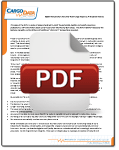Strip Chart Technology
Digital Temperature Recorder Technology Replaces Antiquated Devices
This piece is the first in a series of papers designed to assist the perishable logistics and quality assurance professional, with information about current Cold Chain Monitoring technology. This first installment discusses the features, benefits, and limitations of traditional “strip chart” temperature recorders.
Those of us who are involved in the production and distribution of perishable/temperature sensitive goods have probably, at some point, interacted with a temperature recorder. How do these devices work, and which ones are best? This piece is designed to provide you, the perishable logistics and quality assurance professional, with the technological and historical information you need to determine if traditional temperature recording technology is best for your application.
Back in the Bad Old Days, Receiving personnel had no idea what conditions perishable products experienced in transit. A thorough visual inspection could allow for a best guess, but only that–a guess. The invention of mechanical “strip chart” recorders decades ago was an important breakthrough that allowed Receivers to view a long strip of time-indexed paper which recorded temperatures.
“Strip chart” recorders use bi-metallic coil technology—the same technology used in many home climate control thermostats, toasters, hair dryers, and other household appliances. A pointer, or stylus, is attached to the end of a bi-metallic coil, and that moving pointer can record temperatures on a strip of moving chart paper beneath the stylus. Properly calibrated, such a device, crude as it is, can be used to monitor and record temperatures on the time indexed chart.
While the bi-metallic coil is a proven, time-honored technology, it has a number of limitations. Take accuracy for instance. Bi-metallic coil “strip chart” temperature recorders on the market today are typically calibrated to “plus or minus 2 degrees” Fahrenheit. This wide margin for error means a shipment requiring 33 degree F optimum storage conditions could have been 31 degrees or 35 degrees. Either extreme would be within “strip chart” recorder specifications, yet either extreme could damage the product. When temperature damage to product is observed, but the strip chart indicates proper temperatures, an unpleasant, perhaps costly, dispute is likely to ensue.
Bi-metallic coil “Strip Chart” temperature recorders are also subject to a number of mechanical limitations.
- It is not uncommon for the paper rolls to jam or tear, especially in damp conditions
- The data on the paper charts is not easily shared—the paper strips are too long to easily fax or scan
- Longer recording periods dramatically reduce data accuracy
- The paper strip charts do not allow for positive date/time documentation-only an elapsed time reference from when the unit was started
- Accuracy of the data can only be verified if the bulky bi-metallic coil unit is retained for calibration review.
- Archiving strip chart data requires hard copy filing while many firms are increasingly relying on digital file storage.
- No means to automatically produce summary data reports
While bi-metallic coil “Strip Chart” temperature recorders have met temperature monitoring needs in many industries for decades, product safety and traceability programs have become more sophisticated and more important. As such, perishables logistics and Quality Assurance professionals will be increasingly responsible for accurately monitoring cold chain integrity. Most such professionals are phasing out obsolete bi-metallic coil technology and are embracing superior digital technology for its improved accuracy, archiving, adaptability, and data sharing attributes. You should too.
Digital Temperature Recorder Source: Cargo Data Corporation (www.cargodatacorp.com) of Ventura, CA offers the Automated Temperature Monitoring System designed to simplify cold chain monitoring at every level. Cargo Data provides Select Radio Frequency enabled transit digital temperature recorders, Express handheld data retrieval device, iMAT real-time temperature monitoring systems, Boomerang Reusable recorders, KoldLink App free full-featured desktop software, and much, much more.
Stay tuned for a Digital Temperature Recorder Buyers Guide.
For more information, contact Cargo Data Corporation:
information@cargodatacorp.com or 800-338-8134.

